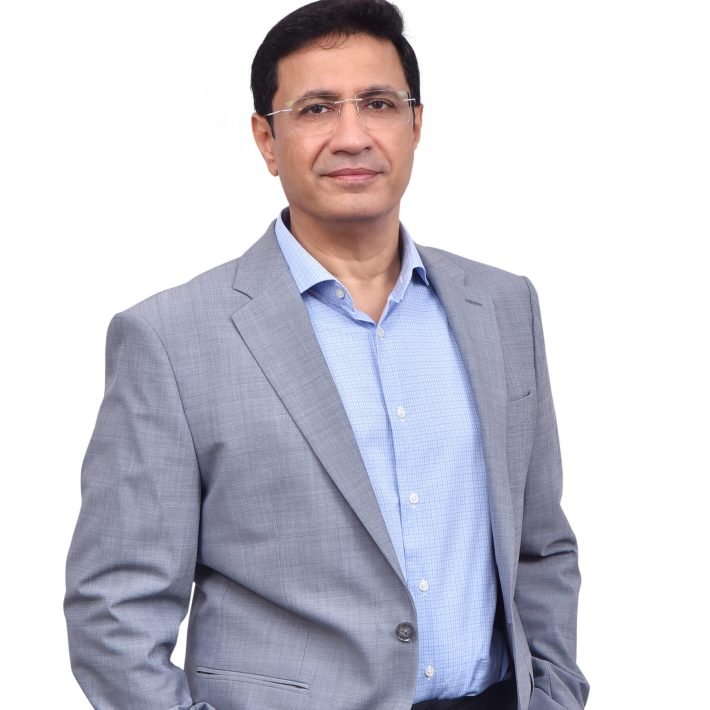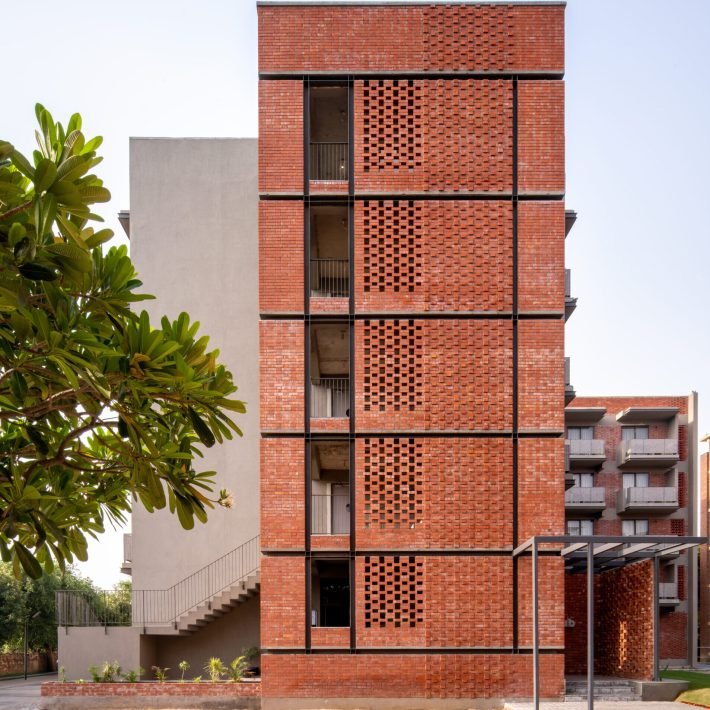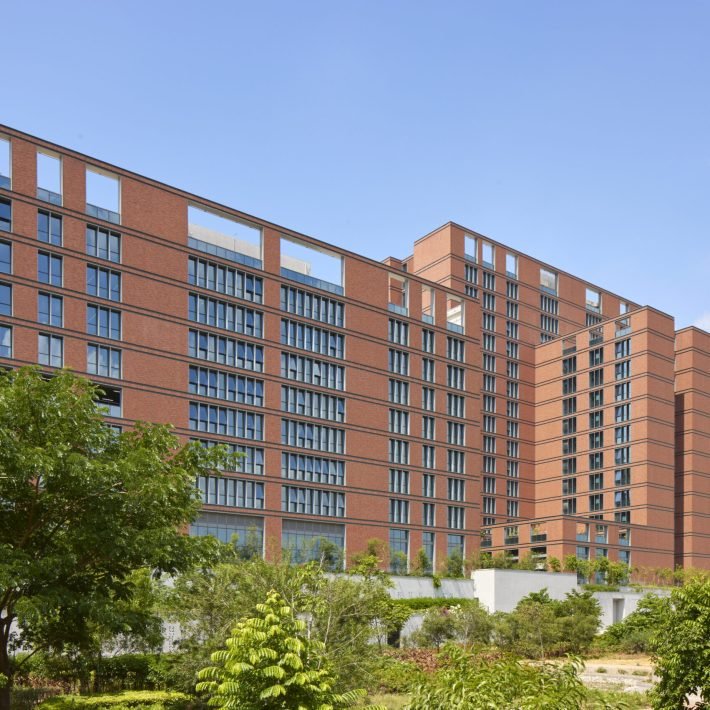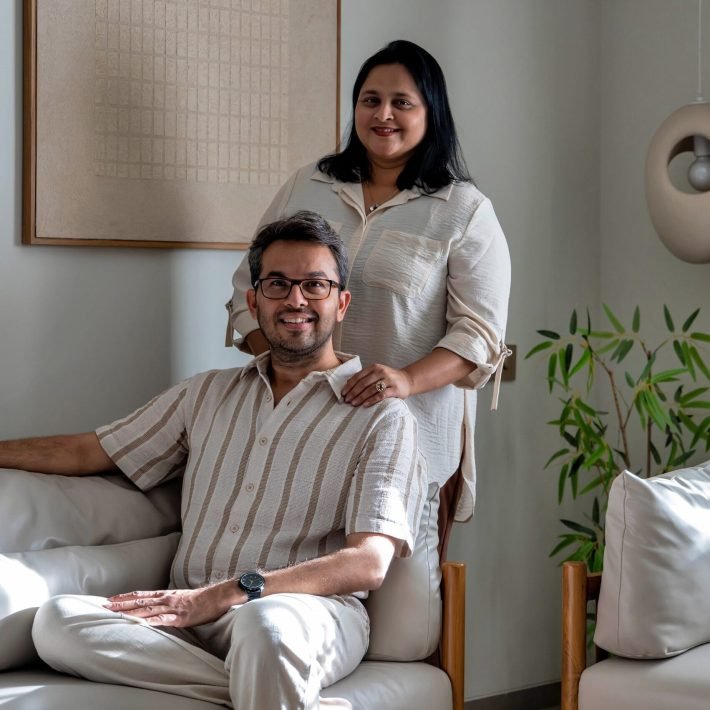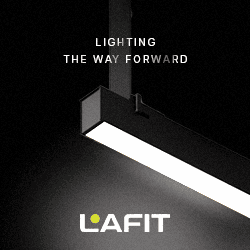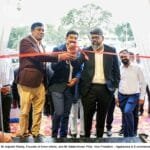Morphogenesis is a prominent architecture firm known for its groundbreaking work. Through this article, we highlight how Morphogenesis skillfully tackles a wide range of design challenges. Their projects reflect a unique blend of creativity, practicality, and visual appeal, illustrating the firm’s talent for turning ambitious architectural ideas into influential and functional spaces.
Morphogenesis is India’s leading Architecture and Urban Design practice with offices in Mumbai, Pune, Bengaluru, and New Delhi. The firm was set up by Sonali and Manit Rastogi in 1996 with a vision of defining sustainable architecture for contemporary India.
Morphogenesis has been consistently ranked among the Top 100 Architectural Design Firms worldwide by Building Design Magazine, UK in WA100. The practice is the recipient of over 120 awards and has been featured in over 850 publications, both International and National.
“Our design approach has often been inspired by the vast repository of historical wealth of building knowledge and the strong arts and crafts traditions of the region. We understand that we often work in an environment with limited resources, and therefore, we deploy passive strategies by responding to the local climate and ecology while addressing comfort, safety, and liveability parameters. Further, we believe each project must establish itself as a benchmark for innovative design by thinking systemically about sustainability. Architecturally, we celebrate identity and diversity versus visual homogeneity.” says Sonali Rastogi.

Sonali has worked across a diverse canvas ranging from architecture to urban design, landscape, interior design, and art and sculpture. Her professional portfolio includes several significant institutions, select residences, hotels, commercial buildings, residential complexes, and Smart Cities across India, Bhutan, South Africa, Nepal, Bangladesh, The UAE, Sri Lanka, and Afghanistan. She believes that each project must establish itself as a benchmark for innovative design by thinking systemically about sustainability to create a large-scale impact.
Sonali has had a significant influence on the emerging generation of Indian architects through her involvement in architectural education and as a role model for the profession. She is a leading speaker on Sustainable Architecture and has lectured at numerous reputed universities and conferences worldwide. Sonali is also a prolific design author and has co-authored Morphogenesis’ first monograph ‘Morphogenesis: The Indian Perspective, The Global Context,’ published by Images Australia under their Master Architect Series.
She has brought significant attention to gender issues. Today, Morphogenesis is an exemplar of the profession for equal opportunity and gender pay parity. A strong proponent of the ‘arts and crafts,’ Sonali is a founder of Manthan, a platform for creative individuals seeking to share, discuss, engage with, and evolve concepts and ideologies. She has been actively engaged in creating conversations around stories of untold monuments and sites of India through the ILF (India Lost & Found) initiative.
She and her partner Manit are the only Indian Laureates of the Singapore Institute of Architects Getz Award for their significant contribution to shaping Asia’s changing landscape.
Society Interiors and Design speaks to Sonali Rastogi, Founding Partner, Morphogenesis about their design journey, their passion for design and their trendsetting projects.
What are the thoughts that cross your mind when you take on new projects?
While working on any project, we look at nature, culture, and context to serve as our inspirations. We draw from the surrounding environment, local traditions, and the needs and aspirations of the community to design buildings that are both relevant and timeless.
Each day sparks a sense of inquiry that encompasses all facets of our work—whether initiating a new project, contemplating specific materials, engaging in collaborative brainstorming with talented engineers for innovative solutions, or pondering marketing challenges that a project might address. It’s a continuous stream of thoughtful exploration when working on new projects.
Do you find it difficult to consistently develop innovative designs for such diverse needs?
We strive to ensure that projects are both economically viable and globally pertinent by integrating passive design strategies that respond to local climate and ecology. Optimisation of resources is a fundamental aspect of our architectural approach and this clarity of thought has guided us towards sustainable outcomes.
For example, the Lodsi Community Project, a manufacturing facility for Forest Essentials in Rishikesh, is deeply rooted in its regional context through its materiality and construction techniques and is an example of how architecture can promote socio-cultural sustainability. Similarly, the new Surat Diamond Bourse embodies our design principles on a far bigger scale, standing as the world’s largest office building and showcasing our commitment to innovative and sustainable architecture.
What are your best personal experiences while working with a diverse national and international clientele?
At Morphogenesis, we have had the privilege of working across various regions in India, encompassing a wide range of climatic zones. Additionally, we have undertaken several international projects and collaborated with international clients who build in India, including both corporate and individual clients. This diversity excites us, as it offers opportunities to learn about different cultures and climates, allowing us to create bespoke responses tailored to each unique context.
This process of discovery, fueled by diversity, keeps our creative energy vibrant and provides a window into various cultural landscapes. Given that architecture and interior design are deeply rooted in their contexts—whether environmental, cultural, social, or aesthetic—we strive to integrate these elements, resulting in a highly satisfying and enriching experience.
What defines your work?
Architecturally, we take a position of celebrating identity and diversity versus visual homogeneity. All our projects across all levels of diversity are examined through the lens of our copyrighted design philosophy, SOUL, which encapsulates the key parameters we believe every structure should fulfil – Sustainability, Optimisation, Uniqueness, and Livability. These principles enable us to take on projects of varying scales and typologies and still develop contextual solutions every time. They also guide us toward exploring innovative environmental, social, and economic sustainability solutions. It is this inclusive nature of design with a focus on passive and low-energy architecture that we believe in and hope to contribute to new, emergent architecture.

What type of projects challenge you the most?
At Morphogenesis, every project comes with its challenges and if it doesn’t, we create them, because we aim to try something innovative and new with everything we work with. This drive manifests at various levels, whether at the master planning stage or down to a single detail.
Having won so many national and international awards is there something more coveted that you aspire for?
Morphogenesis was established with the vision of elevating Indian design to a global platform and contributing to its international recognition. Today, I am proud to say that we have made significant strides toward that goal. However, this achievement is not just about Morphogenesis; it’s about the entire community of Indian architects who have risen to this challenge over the past two decades. The global significance of Indian design was further highlighted when Shri B.V. Doshi won the prestigious Pritzker Architecture Prize.
Our ongoing aspiration is to gain even more recognition across different parts of the world, whether through awards, publications, or international projects. It is not about prioritising any specific award but rather about expanding the footprint of Indian design globally. This aspiration continues to grow, fueled by a desire to showcase the richness and diversity of Indian architecture on the global stage.
Do you think we’re at par with the West regarding architecture and design?
When comparing architecture and design standards with those of Western countries, it’s crucial to recognize that design must be adapted to local climatic and geographical conditions. Simply replicating Western design patterns in India, where climatic zones and socio-cultural contexts differ significantly, is not practical and will not yield successful results. However, integrating Western technical expertise with an understanding of local climate and cultural needs can lead to highly successful and contextually appropriate buildings.
It is not about Indian or foreign designers or designs, but is about the building physics, and cultural needs of the people. All these aspects need to be looked into and the practitioners that understand these aspects and their inter-related dynamics will design a successful building in India. But I am not a huge proponent of taking a blue glass tower from New York and building the same in Noida.

What are your forthcoming projects?
We are currently working on a wide range of projects that vary in typology, scale, climate, and cost, with many nearing completion. Among our ongoing commercial projects, several are currently in various stages of design. A notable project underway is the Taj Bangalore International Airport Limited (BIAL). Strategically situated opposite the Kempegowda International Airport, the hotel is designed to represent a luxurious blend of art and opulence, integrating a global contemporary ethos.
We are also designing three esteemed institutional projects across the country: a school in Gurugram, the Vidyashilp Academy in Bengaluru, and a school in New Delhi. Featuring state-of-the-art infrastructure, including a 400-seat auditorium, sports block, and advanced laboratories, the school in Gurugram aligns with global standards of institutional architecture. The classroom interiors utilise a curated palette of pastels and warm wood tones, creating an inviting and pleasant atmosphere for students. Meanwhile, the school in New Delhi incorporates brick as its primary material with hues of brown, white, and kiln-red, maintaining the building’s original character. Designed to take full advantage of the Garden City’s climate, the layout of Vidyashilp Academy in Bengaluru strategically directs gentle breezes through the multiple courtyards that break up its built mass.
An interesting project nearing completion is an architect’s residence in Panchsheel Park, New Delhi, which seamlessly blends architecture, art, and landscape to create a warm and inviting oasis amidst nature.
How has technology influenced design?
Architecture and design today have evolved into a collaborative practice intricately connected with technology and engineering. At this very moment, it seems as though technology is racing ahead, outpacing physical architecture. This rapid evolution appears to stem from a newfound awareness of the changes around us and consequential environmental concerns.
As we navigate through these changes, it is evident that we will adapt to environmental forces driven by the evolution of technology. This sets the stage for an exciting future where people, technology, and architecture come together, connecting our past and future. Design must not only keep up but also use technological growth to create new solutions for today’s challenges.
What is your take on sustainable architecture?

Sustainability is about creating maximum impact with limited resources and zero waste, and nature has always been one of the best examples of sustainability. At Morphogenesis, we look at sustainability holistically – through the lens of environment, economics, and social impact. It is not treated as a layer of applied technology on building systems but forms the very basis of our design. Each project is conceived through a research-oriented approach to policy, planning, design, technology, passive and low energy design. Sustainability is a medium to merge the social, cultural, financial and technological aspects of design, and sustainable architecture plays an extremely critical role in the future of our habitats, ecology and way of life.
Your message to the budding and aspiring architects from India.
I strongly believe that without a clear vision for your future goals, any job would suffice. But why specifically choose architecture? It’s a challenging profession, and the financial rewards may not always be substantial. So why do we pursue it? If we intend to take up the role of architects, we must possess the vision and passion to drive us forward. Our philosophy in life, as it pertains to our work and profession, is that architecture & design is a way of life, and it calls for a lifetime of commitment and conviction.
Society Interiors and Design has curated a selection of projects from Morphogenesis’ extensive portfolio. Each project reflects Morphogenesis’ ability to adapt and excel across different styles and challenges, demonstrating their commitment to creating impactful and sustainable environments.
INFOSYS CAMPUS, NAGPUR
The Infosys Campus in Nagpur redefines sustainable architecture, offering a state-of-the-art workspace for over 2,000 employees in its initial phase. The campus’s efficient layout strategically places Offshore Development Centers (ODCs), optimising workflows and promoting productivity. The building’s distinct X-shaped plan maximises diffused daylight penetration and limits heat gain. The narrow depth of each of the wings further ensures that 90% of the workspaces are completely day-lit.

The vibrant facade is inspired by swaras (Indian classical music notes) and tiger’s skin grooves. It features vertical fins strategically oriented at varying angles to serve as shading devices while simultaneously adding a sense of visual dynamism. Orange forms the base hue, and earthy tones are added to develop a gradient, establishing a sense of play and rhythm.

Along with a radiant waffle cooling system that harnesses the thermal mass of concrete slabs for natural temperature regulation, these design interventions dramatically reduce energy consumption, achieving a remarkable 52% reduction in the Energy Performance Index (EPI) compared to conventional office buildings. The design also prioritises employee well-being with amenities and diverse workspaces, while seamlessly integrating local art and culture into the architectural fabric. The Infosys Campus stands as an exemplary model for future sustainable workspaces in India, demonstrating how innovative design can harmoniously address environmental, functional, and cultural imperatives.
LALIT SURI HOSPITALITY SCHOOL, FARIDABAD

The Lalit Suri Hospitality School in Faridabad stands as a testament to sustainable and innovative design. The building seamlessly merges with the surrounding landscape, achieving a zero-tree-cutting goal while incorporating landscaped courtyards and locally sourced brick construction. Spaces within the school are designed for flexibility, serving dual purposes for education and hands-on hospitality training. This is exemplified by stepwells transforming into open-air theatres, cafeterias functioning as F&B training outlets, and hostel accommodations adopting a hotel format, offering students real-world experience.

Furthering its sustainable commitment, the building employs brick cavity walls, terrace gardens, and cantilever projections to reduce heat gain, and is partially sunken for thermal banking and noise reduction. The result is net-zero energy consumption for academic areas, with an impressive EPI of ≤58kWh/sq.m./yr, and net-zero water usage during monsoons, aided by bioswales. This holistic approach establishes the Lalit Suri Hospitality School as a pioneering model for sustainable education, seamlessly integrating environmental responsibility, innovative design, and hands-on learning.

ZYDUS CORPORATE PARK, AHMEDABAD

Zydus Corporate Park in Ahmedabad is a modern workplace inspired by Gujarat’s architectural heritage. A robust monolith with a peaked profile, the building’s fortress-like form references mediaeval-era monuments from the walled city of Ahmedabad: the Bhadra Fort, the Pavagadh Fort, the stepped courts of Adalaj, as well as from the traditional ‘Bhunga’ architecture of Kutch.


The Pavagadh Fort provided key contextual cues for the three rampart-like walls forming the western facade, effectively screening the interiors from the harsh summer sun and providing a thermal buffer against extreme temperatures. These doubly-curved Corten steel bulwarks are articulated in the intricate geometries of Ahmedabad’s traditional metal craft of the ‘Kansaras’, translated parametrically through computational design.

The building incorporates passive design and climate-responsive strategies, resulting in a significant reduction in energy consumption. Inside, the layout prioritises employee interaction with a central spine housing social spaces and connecting formal work areas. This flexible zone also allows for greater spatial distribution of the workforce when needed. Local crafts and construction methods are integrated throughout the project. By blending traditional elements with contemporary design, Zydus Corporate Park sets a new standard for sustainable and culturally relevant commercial architecture.

VIDYASHILP ACADEMY, BENGALURU

Embedded within 17 acres of teak plantation, the Vidyashilp Academy is designed with the intention of preserving up to 700 trees on the site. Taking full advantage of Bengaluru’s temperate climate, the school’s layout strategically directs gentle breezes through the multiple courtyards that break up its built mass. These open spaces function as green lungs and create a flexible programme, expanding the role of education beyond the traditional classroom.
Classrooms feature walls that stop short of the ceiling, promoting the free flow of natural breezes and reducing the need for air conditioning. Jaali-inspired elevational panels serve as both sun and privacy screens, allowing for uninterrupted cross-ventilation while providing shade and seclusion. The design prioritises student well-being with dedicated areas for relaxation and encourages physical activity amidst natural surroundings. The building itself showcases a harmonious blend of simple and cutting-edge materials, resulting in a space that is both functional and aesthetically pleasing, fostering a sustainable and inspiring educational experience.

Morphogenesis not only addresses the unique needs of each project but also pushes the boundaries of modern design. Their work stands as a testament to their commitment to excellence, sustainability, and creativity in architecture. Through these projects, Morphogenesis continues to redefine the possibilities of design, leaving a lasting impact on the built environment.



